Chinese Dynasty: Northern Song - A Glorious Era of Culture and Innovation
The Northern Song Dynasty (北宋, Běi Sòng), which reigned over China from 960 to 1127 CE, is widely regarded as an era of great achievements and innovation in Chinese history.
During this period, the Chinese economy grew rapidly, and the population increased significantly. The dynasty saw great advancements in science and technology, including the application and spread of gunpowder, the use of the compass, and the development of movable type printing. It was also known for its art and literature, especially Song Ci poetry which left an indelible mark on Chinese literature.
The Northern Song Dynasty left a profound and lasting impact on China and the world. From its administrative reforms to artistic achievements, the Northern Song Dynasty's legacy continues to shape modern China and influence global perceptions of Chinese culture and civilization.
Our last article focused on the historical journey of the Northern Song Dynasty. In this article, we will explore the extraordinary achievements, innovation, progress, and enduring legacy of this era.
Politics
Administrative System
The political system of Northern Song largely followed that of the Tang Dynasty (唐朝), that is, the Three Departments and Six Ministries system (三省六部制). However, Song introduced checks and balances among different offices, reducing the power of chancellors (宰相) and strengthening the emperor's authority. New supervisory institutions allowed the emperor to have more control.
A system where official titles were separate from actual duties was also implemented, another effort to strengthen centralized authority.
These measures played a significant role in resolving issues of powerful regional governors that had persisted since the mid-Tang Dynasty, helping to maintain national unity and contributing to socio-economic development. However, while addressing conflicts between the central government and regional powers, these measures also sowed the seeds of "accumulated poverty and weakness" (积贫积弱).
Scholarly Governance and Civil Service Examination
A policy of Governing by Scholars (文人治国) was adopted through reforms during the Northern Song Dynasty. Emperor Taizu (宋太祖) adopted the civil service examination system as the fundamental means of selecting talent, allowing individuals from all backgrounds to enter the imperial court. Civil officials held top administrative positions, surpassing military officials in status. In this era, the military had no permanent commanders, and commanders had no permanent troops.
Emperor Taizu's principles were generally upheld by subsequent emperors, empowering high-ranking officials and civil servants to voice their opinions, which somewhat constrained imperial authority. Song officials generally had more significant involvement in decision-making and policy implementation compared to previous dynasties.
Debates between rulers and officials were common in the imperial court, while scholars outside the court could also provide insights on state matters. The enlightened political atmosphere cultivated idealism among intellectuals and promoted cultural innovation.
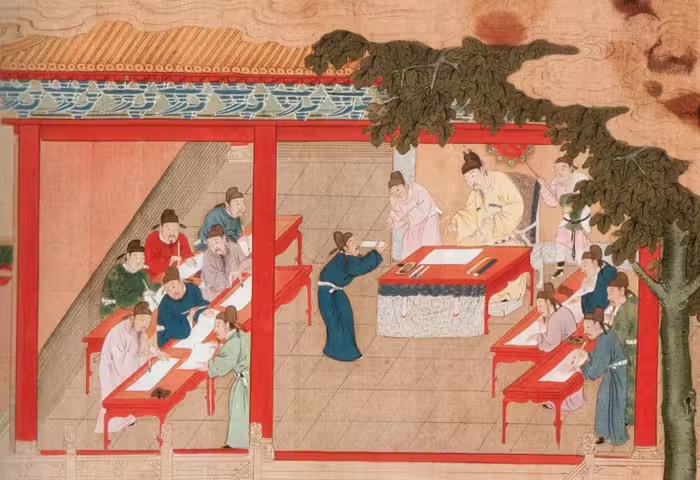
An illustration of the emperor receiving a candidate during the Palace Examination, Song Dynasty
As for the civil service examination system, Emperor Taizu broke from tradition by implementing the final examination known as the palace examination (殿试) to assess candidates. This led to the growth of a strong bureaucratic class and produced a substantial number of outstanding politicians, consolidating the regime's power.
Over time, Song implemented various measures to improve the examination process, including strict procedures, increased candidate quotas, and better treatment for successful individuals.
By integrating a substantial number of intellectuals into the bureaucracy, Northern Song further consolidated the foundation of its rule.
Economy
The Northern Song Dynasty experienced a remarkable period of economic growth and urbanization. The government's focus on agricultural development, including the widespread use of new farming techniques and expansion of irrigation systems, led to increased agricultural productivity. This, in turn, supported a growing population and the rise of prosperous urban centers. The number of cities with over 100,000 households increased from about a dozen in the Tang Dynasty to over forty.
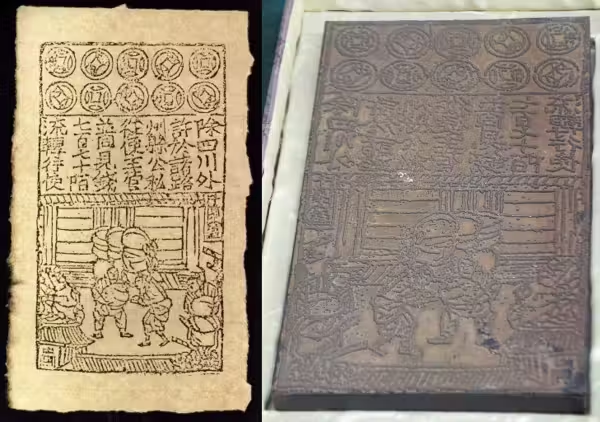
Jiaozi (left) and corresponding printing plate (right) from Northern Song
This era also saw the world's earliest paper currency, Jiaozi (交子).
As trade and commerce thrived, the volume of currency in circulation increased significantly. Northern Song's monetary system included copper and iron coins, as well as gold and silver as semi-circulating currencies, primarily used for taxation, official salaries, and foreign trade.
In Sichuan, during the late 10th century, privately owned Jiaozi shops (交子铺) emerged, issuing paper currency Jiaozi to replace heavy metal coins. The government later formalized this by establishing the Jiaozi Bureau (交子务) with a reserve of iron coins and expanded its circulation, making it the world's first government-issued paper-printed money.
This early use of paper currency in China was a significant development in the history of money and finance.
The economic prosperity of Northern Song fostered market competition, with various industries adopting unique business practices. Many merchants used advertising to compete for customers. Various forms of advertising emerged, such as audio advertisements, product displays, hanging advertisements, and holiday promotions.
Northern Song's overseas trade expanded significantly from that of the Tang Dynasty.
During the mid-Northern Song, annual customs revenue became a crucial source of government income. Exported goods included silk textiles, ceramics, and metals, while imports comprised spices, medicinal herbs, ivory, and jewelry.
Northern Song's shipbuilding led the world at the time, and most Chinese and foreign merchants used ships made in China for their trade.
During Emperor Taizong's reign (宋太宗, 976-997), over 3,300 ships were constructed annually nationwide, largely surpassing the Tang Dynasty. During Emperor Huizong's reign (宋徽宗, 1100-1126), the Shenzhou ship (神舟), built for a diplomatic mission to Goryeo (高丽), was estimated to carry over 1,100 tons.
Handicraft production thrived during the Northern Song period. Workshops in various crafts had expanded scale and intricate specialization beyond previous eras. Technological advancements led to a significant increase in the variety, quantity, and quality of products. Notably, the Northern Song period was renowned for its ceramics.
Northern Song ceramics improved significantly in both production volume and craftsmanship. Kilns for producing ceramics spread across the country, each known for producing distinct types of ceramics. Song ceramics were not only everyday items but also exquisite works of art. They were widely exported, with many unearthed in various regions of Asia and Africa, highlighting the importance of ceramics as a significant export product of the time.
Science and Technology
The Northern Song Dynasty's scientific and technological achievements had a profound impact on the world and laid the groundwork for future advancements in various fields.
Gunpowder: The application of gunpowder in warfare began during the late Tang and expanded significantly during Northern Song. A dedicated institution in the capital Kaifeng was established for manufacturing firearms, and gunpowder technology spread to Europe through West Asia.
Compass: The compass started to be utilized for navigation during the Northern Song. The technique of artificially magnetizing natural magnets was mastered during this time, resulting in more stable artificial magnets compared to natural ones.
Printing: Movable type printing (活字印刷术) was invented during the Northern Song and significantly impacted Chinese society by accelerating book production, making books more affordable, and contributing to the expansion of the educated scholar class. While woodblock printing (雕版印刷术) remained dominant due to challenges of the Chinese character writing system, movable type printing continued to evolve, and eventually was adopted by massive printing projects during the Qing Dynasty (清朝).
Encyclopedia: Northern Song scientist Shen Kuo (沈括) wrote Dream Pool Essays (《梦溪笔谈》), a comprehensive work that extensively documented contributions of the people, as well as his own research achievements, reflecting remarkable accomplishments in natural science, especially during the Northern Song era. The content involved disciplines such as astronomy, mathematics, physics, chemistry, and biology. It was considered one of China's ancient encyclopedias.

Left: bust of Shen Kuo at the Beijing Ancient Observatory.
Right: illustrations of Shen Kuo's techniques of small increments (top) and intersecting circles (bottom).Mathematics: Shen Kuo excelled in various practical mathematical problems, including complex formulas for geometry, circle packing, and trigonometric chord and arc problems. His "technique of small increments" (隙积术) covered methods of calculating the volumes of irregular shapes, and his "technique of intersecting circles" (会圆术) explored methods for approximating the value of pi. Shen Kuo's research laid the foundation for further developments in these areas.
Astronomy: Northern Song astronomer Su Song (苏颂) engineered a 12-meter-tall water-powered astronomical clock tower (水运仪象台) constructed in Kaifeng. The tower had various functions including an armillary sphere for observing celestial phenomena, a celestial globe for demonstrating celestial events, a clepsydra for measuring time, and a mechanism for reporting the time. These were driven by an early intermittently working escapement mechanism.
In addition, he completed a large celestial atlas of several stars and terrestrial maps and also authored a treatise on pharmacology, which discussed subjects including mineralogy, zoology, botany, and metallurgy.
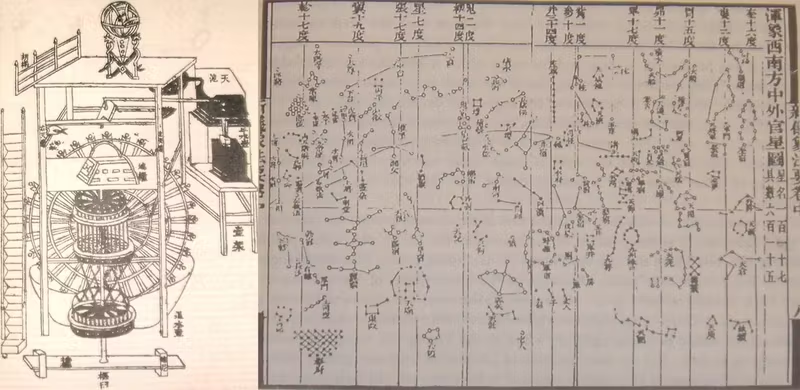
An interior diagram of the astronomical clocktower of Kaifeng (left) and a star map with an equidistant cylindrical projection (right) from Su Song's Xinyi Xiangfayao.
Medicine: Northern Song witnessed significant advancements in pediatric medicine, with notable figures like Qian Yi (钱乙), hailed as the saint of pediatrics. Progress was also made in understanding and treating diseases like smallpox, measles, convulsions, and malnutrition. During the Tang Dynasty, treatment for injuries didn't have a clear distinction between surgery and trauma treatment, which became more specialized during Northern Song.
Culture
The Song Dynasty was a time of cultural flourishing in China, marked by significant achievements in literature, art, science and technology. The civil service examination system allowed intellectuals to thrive, and the era saw the widespread dissemination of printed materials, and a thriving porcelain industry, which all promoted the exchange of literature and the appreciation of art.
Northern Song was a haven for literary and artistic talent, producing numerous renowned figures who reached the pinnacle of their respective fields. It stands as one of the most culturally vibrant periods in Chinese history.
Literature
Among the Eight Masters of the Tang and Song (唐宋八大家), only Han Yu (韩愈) and Liu Zongyuan (柳宗元) hailed from the Tang Dynasty, while the other six were from Northern Song, including the Three Sus (三苏) - Su Xun (苏洵), Su Shi (苏轼), Su Zhe (苏辙), as well as Ouyang Xiu (欧阳修), Wang Anshi (王安石), and Zeng Gong (曾巩).
While Song Dynasty poetry (诗, shi) may not have reached the heights of Tang, it had its distinct characteristics. Song poetry often leans towards reasoning and discourse, excelling in presenting logical arguments. It approaches objective phenomena with a calm demeanor, preferring a scholarly and profound style with frequent use of references and allusions. Song poetry often incorporates prose-like structures, sentence patterns, and narrative techniques, displaying a tendency towards a more prose-like style.
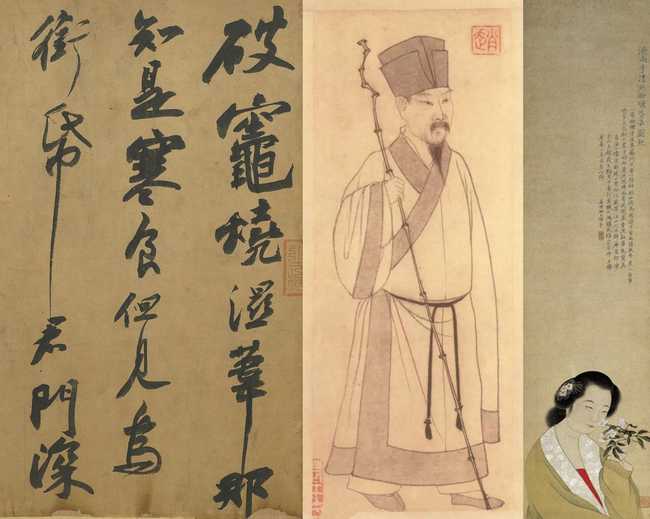
Left: calligraphy by Su Shi - A detail of The Cold Food Observance.
Middle: a portrait of Su Shi. Right: a portrait of Li Qingzhao.
On the other hand, the Song Dynasty achieved remarkable heights in the realm of ci poetry (词). Song ci (宋词), alongside Tang poetry (唐诗), is considered a treasure of classical Chinese literature and art.
Ci poetry, characterized by its varying line lengths and suitability for singing, represents the pinnacle of intellectual and artistic expression in the Song Dynasty. It began during the Tang Dynasty, thrived during the Five Dynasties period (五代), and reached its zenith during the Northern and Southern Song periods. Numerous renowned ci poets emerged during Northern Song, including Su Shi, Liu Yong (柳永), Li Qingzhao (李清照), Ouyang Xiu, Yan Shu (晏殊), Fan Zhongyan (范仲淹), Qin Guan (秦观), and Huang Tingjian (黄庭坚).
Art
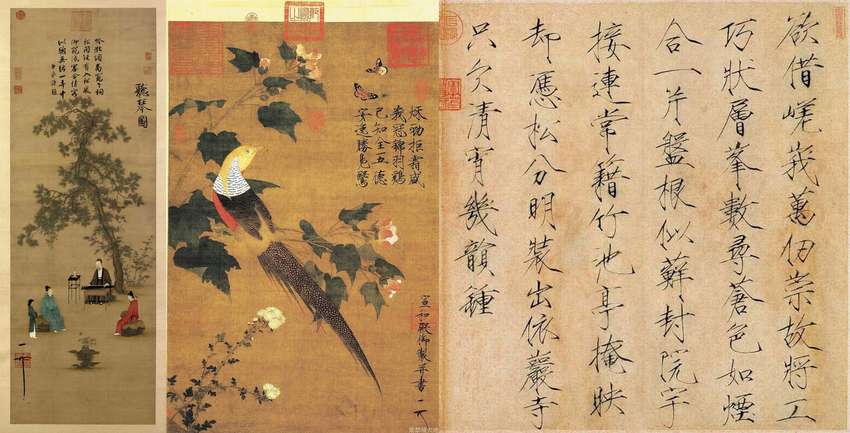
Paintings and calligraphies by Emperor Huizong of Song.
Left: Ting Qin Tu ("Listening to the Qin"). Middle: Golden Pheasant and Cotton Rose Flowers. Right: a part of a poem and calligraphy.
In calligraphy, Su Shi, Huang Tingjian, Mi Fu (米芾), and Cai Xiang (蔡襄) achieved the highest recognition and were collectively known as the Four Calligraphers of Northern Song (北宋四大家). Additionally, Emperor Huizong (宋徽宗) created the distinctive Slender Gold (瘦金书) style of calligraphy, drawing from the strengths of others and infusing it with his unique personality.
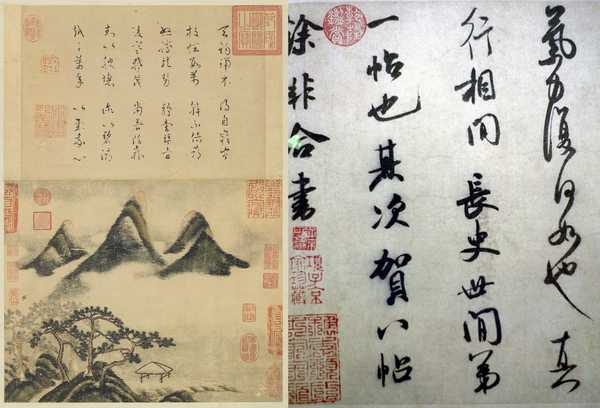
Painting and calligraphies by Mi Fu.
Left: Mountains and Pines in Spring. Right: calligraphy (ink on paper).
As for painting, early Northern Song painters included Li Cheng (李成), Fan Kuan (范宽), and Wen Tong (文同). In the middle to late period, artists like Su Shi, Li Gonglin (李公麟), Zhang Zeduan (张择端), Mi Fu, and Emperor Huizong excelled. Northern Song landscape painting, known for its outstanding artistic prowess, reached its pinnacle. The most iconic work is Zhang Zeduan's Along the River During the Qingming Festival (《清明上河图》), a scroll vividly depicts the scenery of capital Kaifeng, with nearly six hundred people bustling in a masterpiece that stands as an enduring treasure in the history of Chinese painting.
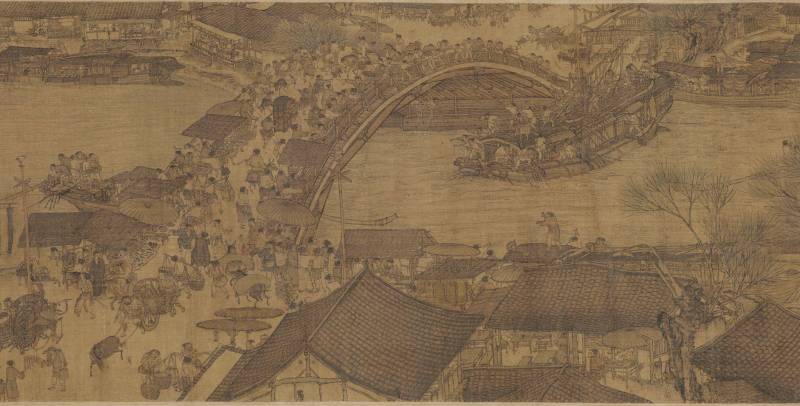
A section (the bridge scene) of Along the River During the Qingming Festival by Zhang Zeduan.
Historiography
Both the New Book of Tang (《新唐书》) and the Historical Records of the Five Dynasties (《新五代史》) compiled during Northern Song were among the Twenty-Four Histories (二十四史), with annals and biographies as their primary content. The former was compiled under the supervision of Ouyang Xiu, while the latter was a private effort by Ouyang Xiu himself.
Sima Guang's (司马光) contributions were even more profound. His Zizhi Tongjian (《资治通鉴》, Comprehensive Reflections to Aid in Governance) stands as the pinnacle and comprehensive work of chronological history in ancient China. Covering events from the Partition of Jin (三家分晋, 403 BCE) to the end of the Five Dynasties (in 959 CE), it chronicles 1362 years of history. The book delves into the details of the rise and fall of states and their impact on the people, serving as a valuable source of past events and guidance for both good and bad actions in governance.
Philosophy
Northern Song far surpassed Tang in the field of philosophy, giving rise to a group of Neo-Confucian (理学) scholars. Neo-Confucianism is a specialized form of Confucian philosophy that places a strong emphasis on the exploration of principles, the nature of life, and morality.
Key founders of Neo-Confucianism included the Five Masters of Northern Song (北宋五子), namely Zhou Dunyi (周敦颐), Zhang Zai (张载), Shao Yong (邵雍), Cheng Hao (程颢), and Cheng Yi (程颐).
Enduring Legacy
The Northern Song Dynasty was a unique period in Chinese history. Despite its large military size, it had weak military strength and faced challenges in conflicts with neighboring powers like the Liao Dynasty (辽) and Western Xia (西夏). Though economically prosperous, the government often struggled with empty treasuries, leading historians to consider it one of China's weakest dynasties.
However, the Northern Song Dynasty was one of China's most technologically advanced, culturally vibrant, and artistically prosperous periods. Many significant Chinese inventions emerged during this era, and urban life rivaled that of any other global city. The period produced a plethora of literary and artistic talent, making it one of the most culturally flourishing and influential epochs in Chinese history. Therefore, some also believe that the Northern Song Dynasty was the most prosperous period in ancient Chinese history in terms of economy and culture.
Read More
The history of the rise and fall of the Northern Song Dynasty